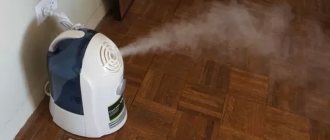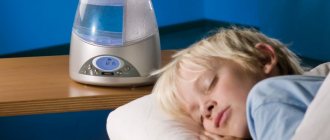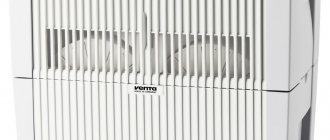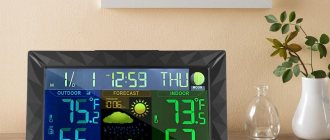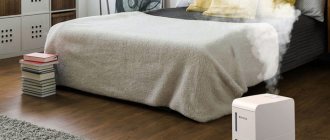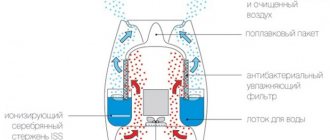Dry air in an apartment is not uncommon, especially during the heating season, when all the moisture evaporates due to radiators and heaters. It harms the human body, plants and even wooden furniture. One of the best inventions for eliminating dryness is a humidifier, which takes up little space and does its job effectively.
But in some cases, the device malfunctions, stops supplying steam and emits an unpleasant odor. Let's consider the reasons for these negative phenomena for the main types of devices.
Types of humidifiers
There are three types of humidifiers:
- Steam. Humidification occurs as a result of heating and subsequent boiling of water. Hot steam can increase air humidity up to 100%.
- Ultrasonic. This is a cold fog generator that quickly creates a high level of humidity in the room.
- Traditional (cold). The principle of operation is that dry air passes through a wet filter and natural evaporation occurs without heating. Thanks to the powerful built-in fan, the evaporated moisture is evenly distributed throughout the room.
How they work
Household appliances tend to fail, so knowledge about the device will help identify the cause of the problem. The design of the device depends on the principle of its operation; a steam humidifier and an ultrasonic one have completely different structures:
- Steam. The humidifier has a built-in water tank and heating element. From the reservoir, water flows through the dispenser in small portions into an insulated heating chamber, quickly boils and evaporates.
- Ultrasonic. It consists of a water tank with a level sensor, a vaporization chamber with an ultrasonic membrane, and a low-power fan. Water through the valve enters the membrane, which vibrates at ultrasonic speed and is broken into small particles. The cold mist is pushed out by the fan.
Reasons for lack of steam and solutions
Lack of steam is one of the most common faults that occurs in all types of humidifiers. Therefore, we will take a closer look at the reasons for such breakdowns for each type of device, and also talk about solutions.
Diagnostics should begin by checking the outlet, the indicator of the electrical device and the presence of water in the tank. But keep in mind that any repair work is carried out only after disconnecting the humidifier from the network.
Cold type devices
So-called traditional humidifiers may stop generating steam for several reasons:
- Worn filters - in this case, the parts should be replaced with new ones.
- Engine malfunction. The unit is responsible for the operation of the turbine and fan. It cannot be repaired, the motor can only be replaced.
- Raid. If you hear the sound of an engine when you turn on the humidifier, but the turbine impeller and cooler remain motionless, the reason may be limescale, which should be removed. Failure can also be determined by the direction of the steam, which will spread below, and not exit vertically upward.
The lack of steam can also be caused by damage to the wires, which often happens when transporting the device.
If there is no movement of the impeller after turning on the device, you should disconnect the device from the mains and try to turn these elements yourself. If movement is difficult, cleaning will be necessary.
Ultrasonic humidifiers
The key element of an ultrasonic humidifier is a membrane or disk (emitter, piezoelectric element) and a low-power fan. The membrane begins to vibrate when alternating current is applied at an ultrasonic frequency, causing the water to break into tiny particles, and the built-in fan pushes them into the room.
Often this type of humidifier produces insufficient steam or no steam at all due to a faulty electromechanical converter. It will not be possible to fix the breakdown on your own; the part must be replaced. A membrane malfunction can be determined by the absence of the characteristic sound of bubbling water.
It is usually impossible to start a humidifier without water - manufacturers have provided that the devices do not start the steam generation process if there is not a sufficient water level
If the humidifier was put into operation without water, the membrane and then the transistor fail. Prolonged operation in this mode can damage other elements of the generator board, which will lead to damage to the power supply.
Another reason for the malfunction of an ultrasonic humidifier is contamination or damage to the membrane, as well as failure of the mechanism that makes it vibrate (ultrasonic vibration generation boards). The problem can be fixed by cleaning the membrane; it may also be necessary to replace the entire device that drives the transducer.
It is also worth cleaning the membrane if too little steam is generated from the humidifier. This can be done using any descaling cleaning products. Vinegar solution and citric acid will also help. The product should be poured into the recess with the membrane and wait until the scale is completely dissolved. Too thick a layer of plaque can be removed with an old toothbrush. Using abrasives or metal objects will damage the membrane.
Steam device failure
These humidifiers often do not produce steam due to a faulty heating element. If the water does not heat up when the device is turned on, the heating element will need to be replaced.
Lack of steam may be due to failure of the impeller, motor, wiring and fan, as is the case with cold-type devices.
If the hygrometer reading does not change during the first days of using the humidifier, the reason may be that the air in the room is excessively dry. You should wait about 5-10 days until all interior items absorb moisture
There is another type of air humidifier - atomizing one, but its repair should be carried out exclusively by specialists. Interfering with the operation of an expensive device can cause harm.
Emerging problems
There is no steam. Causes:
- problems with the generator;
- damaged fan;
- oxidized contacts.
We recommend reading: How to humidify the air in a room?
Unpleasant smell. Causes:
- the water began to bloom;
- There are bacteria in the humidifier.
No air is coming. Causes:
- debris has accumulated in the filter;
- the fan does not work;
- the engine has failed.
No water supplied. Causes:
- The water level sensor stopped working;
- The emitter is broken.
Help: If the device will not be used for some time, the water must be drained from it, as it will stagnate.
DIY repair
If you have no experience in soldering or working with electrical networks, or do not have the necessary tools and equipment, you will not be able to repair the air humidifier yourself after a significant breakdown. Only minor problems can be fixed.
In this case, you should contact a specialized service, where they will try to bring the device back to life at a professional level. If you have experience in soldering and working with electrical equipment, you can repair humidifiers with breakdowns of any complexity.
Disassembly and repair of an ultrasonic air humidifier is carried out only when the device is disconnected from the power supply. The plug is plugged into the socket only when necessary for inspection and testing during troubleshooting.
What equipment will be needed for a complete repair:
- Screwdrivers.
- Pliers, tweezers.
- Soldering iron.
- Tester or multimeter.
To fully repair the humidifier you will need a soldering iron.
Why doesn't the humidifier turn on? You need to check the cleanliness of the filter and replace or clean it if necessary. The device will not turn on if the filter cannot pass moisture. Replacing the filter will correct the situation.
The device will not turn on even if there are problems with the electrical wires, power supply boards and control unit. If the integrity of the wires is damaged, they have moved away from the terminals, there are dark spots on the boards and wires, a thorough repair will be required using a tester (multimeter) or a soldering iron.
The operation of the fan, if the device does not turn on, is checked using a tester. To do this, the voltage on the windings of the electric motor is measured. If the required voltage level is present, the fan should be replaced; that is the problem. If there is no voltage, the problem is in the board.
What should I do if the humidifier does not produce steam? This happens in case of damage to the piezo emitter, oxidation of the contacts of the heating element board, failure of the fan, generator or part of the ultrasonic wave radiation.
You can check the functionality of the generator as follows. Remove the bottom cover of the case, turn on the device for 2-3 minutes. Be sure to remove the plug from the socket and touch the radiator with your fingers. If it does not heat up, the part has failed and needs to be replaced.
To repair the device if there is excessive noise, you need to open the housing, remove it, clean and lubricate the fan. With an air heater, if it does not work, the situation is more complicated. It will have to be replaced if there are any malfunctions.
How to fix a humidifier if it is leaking? You need to open the case and pour water into the tank. Check the tightness of the container, tubes, and tray. When a leak is identified, the defective element must be checked for secure fastening. If this measure does not help, replace the part.
Operating rules
To avoid problems with the device, you should follow certain rules for using a humidifier:
- If possible, fill the humidifier with distilled water, as it contains a minimum amount of unnecessary bacteria, minerals and molecules.
- Change the water every day.
- Wash the container containing the water several times a week without using cleaning products.
- The humidifier should not be located next to a heater, radiator, etc.
- Clean the filter periodically.
- It is necessary that the humidifier stands on a flat surface, in a place inaccessible to children.
- Do not touch the device with wet hands.
- Make sure that no foreign liquid gets into the device.
- Do not pour more water into the container than required.
If you can’t fix the humidifier yourself, you need to contact a specialist, since electronics are a delicate matter.
